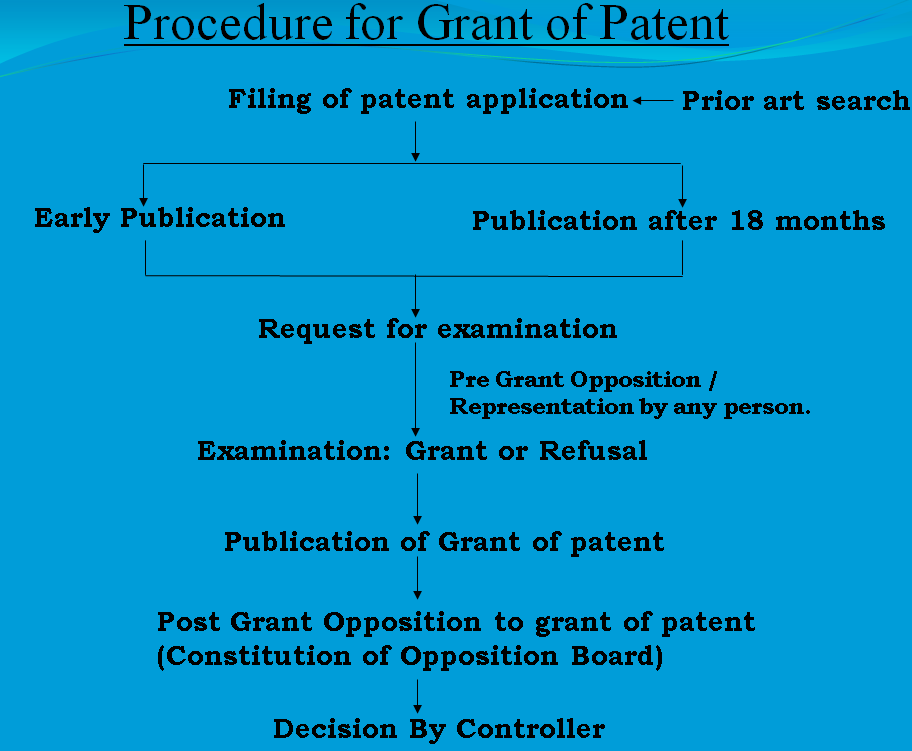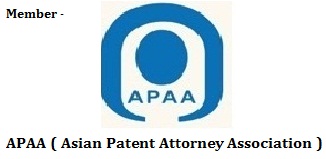
PATENTS
Patent Registration Process
Patent Registration Procedures in India
The Patents Rules, 2003, as amended by The (Amendment) Rules 2006.
Basic Requirements of Patent :-
A. Novelty /Uniqueness .
B. Non – Obvious .
C. Industrial Application .
Filing Application
Any person, even if he or she is a minor, may apply for a patent either alone or jointly with any other person. Such persons include the inventor, or his assignee or legal representative in the case of an ordinary application or, in the case of a priority application, the applicant in the convention country or his assignee or his legal representative. A corporate body cannot be named as an inventor. Foreigners and nationals not living in India need an address for service in India for this purpose. They may appoint a registered agent or representative whose address for service can be the address for service in India.
Place of filing:
An application for patent must be filed at the Patent Office branch within whose territorial jurisdiction the applicant resides or has his principal place of business or domicile. A foreign applicant must file in the Patent Office branch having jurisdiction over the place where his address for service is located.
Priority:
Priority can be claimed from the earliest corresponding application in a convention country, provided that the Indian application is filed within twelve months of the priority date. Multiple and partial priorities are allowed.
Specification:
A priority application must be filed with a complete specification in the first instance but a non-priority application may be filed with either a provisional specification or a complete specification. Where a provisional specification is filed in the first instance, a complete specification must be filed within twelve months. Where two or more provisional specifications have been filed, the specifications may be cognated and all the subject matter may be incorporated into a single complete specification to be lodged within twelve months of the date of the earliest filed provisional specification.
Naming of inventor ( s ) :
As regards non-priority applications, the inventor(s) must be named in the application form. As regards priority applications, a declaration as to inventorship must be filed with the application or within a maximum period of six months.
Information of corresponding applications in other countries:
It is necessary at the time of filing a patent application in India, to inform the Controller of the details of all corresponding applications in other countries and to undertake to keep the Controller so informed up to the grant of the Indian application. Failure to do so could result in the refusal of the application in case it is opposed, or even revocation of a patent in proceedings before the High Court.

Patent Examination
Both formal and substantive examinations are made by the Indian Patent Office. Examination is by request.
Procedure:
An applicant is required to meet all the objections and requirements of the Patent Office within a period of twelve months from the date of the first examination report (FER) issued by the Controller. No extension of time is permitted. If a patent application is not put in order in twelve months from the date of the FER it lapses.
Amendment of application:
An applicant may, of his own accord, apply to the Controller for amendment of his application or any document filed in respect thereof but such amendments must be filed by way of correction, explanation, or disclaimer. An applicant may also amend his application or specification at the instance of the examiner and file a separate divisional application(s) for the other invention(s) which will be accorded the date of filing of the complete specification of the original application or such later date as the Controller may fix. The divisional application must be filed prior to the grant of the parent application.
Patent Publication
Publication takes place 18 months from the date of the application. Urgent publication is possible on request on payment of fees. On and from the date of publication of application for patent and until the date of grant of a patent in respect of such application, the applicant will have the like privileges and rights as if a patent for the invention had been granted on the date of publication of the application.
Pre-Grant opposition of patent application :
After publication but before the date of grant by way of representation, anyone may file opposition to the grant of a patent.
Publication of subject matter:
The grant of an application is published in the official journal and is notified therein for post Grant opposition. A patent can be revoked within one year after grant by postgrant opposition proceedings before the Controller of Patents .
Revocation of a patent:
It is possible on the grounds of prior publication anywhere in the world, public use or knowledge in India, lack of novelty with regard to the subject matter, obviousness, lack of inventiveness, ambiguity, insufficiency of description of the invention, fraud, false suggestion or representation that the person named as the inventor is not the true inventor, lack of utility, non-patentability of subject matter (e.g. food, drug or medicine per se, atomic energy, mere admixture, mere arrangement of known devices, process of testing, method of agriculture or horticulture, process of medicinal treatment), failure to furnish or falsity in material particulars of information regarding corresponding applications in other countries supplied to the Controller or that the invention is contrary to law or morality.
Annuities:
Except in the case of a patent of addition, for which no annuities are payable, annual renewal fees must be paid during the life of an Indian patent, the first of such fees falling due at the end of the second year of the life of a patents granted. Renewal fees falling due during the pendency of the application are payable within a non-extendible period of three months from the date the patent is taken on record in the Register of Patents. Two or more year’s renewal fees may be paid in advance if the patentee so desires. A maximum extension of six months may be obtained on payment of the prescribed penalty fees. If the renewal fee in question is not paid within the extended period available, the patent will lapse.
Restoration:
A lapsed patent may be restored if an application for restoration is made within one year of the date of lapsing of the patent, provided it can be shown that the lapsing of the patent was unintentional and that there was no undue delay in making the application for restoration.
Working of patents:
Every patentee and every licensee is required to furnish within three months from the end of the calendar year in which the patent is granted, a statement as to the extent to which the invention has been worked in India on a commercial scale in the preceding year. Non filing of this statement is a criminal offence.
Compulsory licenses:
After three years from the date of sealing of a patent, an interested party may apply to the Controller for the grant of a compulsory license alleging that the reasonable requirements of the public with respect to the invention have not been satisfied or that the invention is not available at reasonable price. If the Controller is satisfied that a prima facie case for an applicant for compulsory license has been made out, he shall serve notice on the patentees who, if they so desire, may oppose the application for compulsory license.
Marking:
It is not compulsory but advisable as otherwise damages may be difficult to recover in cases of infringement. The invention may be marked with the word “Patented” or “Patent” accompanied by the number and year of the patent.
Infringement:
An infringement suit may be instituted by a patentee or his exclusive licensee. Every ground for revocation is available as a defense and revocation can be counter claimed in infringement proceedings. The Court may grant relief in respect of a valid claim or claims even though one or more other claims in the suit may be held to be invalid. Relief may include damages and costs as awarded by the court. A suit for injunction may be instituted and damages recovered in cases where there have been groundless threats. Any person may institute a suit for declaration as to non-infringement of a patent. Onus of proof of non-infringement lies with the defendant.
Patents and Computer Software
It is possible to patent programs for computers which, when run on a computer produce a “technical effect or includes hardware” . However, if a program does not produce a technical effect when run on a computer it is unlikely to be patentable. A technical effect is generally an improvement in technology and needs to be in an area of technology, which is patentable. For instance, an improved program for translating between Japanese and English is not patentable because linguistics is a mental process, not a technical field. On the other hand, a program, which speeds up image enhancement, may be patentable because it produces a technical improvement in a technical area.
Some countries, such as the USA, which may be a large potential market for your software, have a more liberal approach to software patenting and often grant patents for software, which would be excluded in India and other countries.
Deciding whether or not a particular computer program is patentable is a complex issue and advice from a Patent Agent may help to determine which is the most effective form of protection available.

